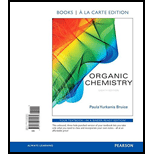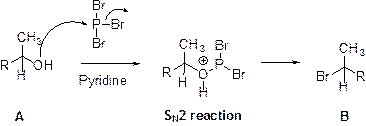
Concept explainers
(a)
Interpretation:
The product of given reaction should be given.
Concept introduction:
In the nucleophilic substitution reaction, the
In
The rate determination step is formation of carbocation.
The stability order of carbocation is,
Tertiary > Secondary > Primary
Therefore, tertiary alcohols undergo substitution very fast than the secondary alcohols because tertiary carbocation is more stable than the secondary carbocation than the primary carbocation. Primary alcohol is less stable therefore it won’t undergoes
In the nucleophilic substitution reaction, the rate of reaction depends on reactant as well as nucleophile, which are involved in reaction is called bimolecular nucleophilic substitution reaction.
In
Reactant and nucleophile are present at the rate determination step.
The order of species involving in
Tertiary < Secondary < Primary
Tosylation reaction:
The alcohol is treated with any tosyl chloride (methane sulfonyl chloride) to yields tosylated product, this reaction is called as tosylation and which is shown below,

(a)
Answer to Problem 55P
The product is given below,

Explanation of Solution
The given Compound (A) is reaction with methane sulfonyl chloride which gives compound (B). This compound (B) reaction with acetate ion and gives the propyl acetate (D). The reaction is given below,

(b)
Interpretation:
The product of given reaction should be given.
Concept introduction:
In the nucleophilic substitution reaction, the rate of reaction depends only on one reactant, which is involved in reaction is called unimolecular nucleophilic substitution reaction.
In
The rate determination step is formation of carbocation.
The stability order of carbocation is,
Tertiary > Secondary > Primary
Therefore, tertiary alcohols undergo substitution very fast than the secondary alcohols because tertiary carbocation is more stable than the secondary carbocation than the primary carbocation. Primary alcohol is less stable therefore it won’t undergoes
In the nucleophilic substitution reaction, the rate of reaction depends on reactant as well as nucleophile, which are involved in reaction is called bimolecular nucleophilic substitution reaction.
In
Reactant and nucleophile are present at the rate determination step.
The order of species involving in
Tertiary < Secondary < Primary
This is shown below,

(b)
Answer to Problem 55P
The product is given below,

Explanation of Solution
Alcohol (A) is reaction with

(c)
Interpretation:
The product of given reaction should be given.
Concept introduction:
In the nucleophilic substitution reaction, the rate of reaction depends only on one reactant, which is involved in reaction is called unimolecular nucleophilic substitution reaction.
In
The rate determination step is formation of carbocation.
The stability order of carbocation is,
Tertiary > Secondary > Primary
Therefore, tertiary alcohols undergo substitution very fast than the secondary alcohols because tertiary carbocation is more stable than the secondary carbocation than the primary carbocation. Primary alcohol is less stable therefore it won’t undergoes
In the nucleophilic substitution reaction, the rate of reaction depends on reactant as well as nucleophile, which are involved in reaction is called bimolecular nucleophilic substitution reaction.
In
Reactant and nucleophile are present at the rate determination step.
The order of species involving in
Tertiary < Secondary < Primary
Tosylation reaction:
The alcohol is treated with any tosyl chloride (methane sulfonyl chloride) to yields tosylated product, this reaction is called as alkyl tosylation and which is shown below,

(c)
Answer to Problem 55P
The product is given below,

Explanation of Solution
The given Compound (A) is reaction with para toluene sulfonyl chloride which gives compound (B). This compound (B) reaction with phenoxide ion and gives the corresponding ether (D). The reaction is given below,

(d)
Interpretation:
The product of given reaction should be given.
Concept introduction:
Dehydration reaction:
Removal of water molecule, when the alcohol is treated with strong acid like sulfuric acid is known as dehydration reaction.

The stability of carbocation is given below,
Tertiary carbocation is more stable than the secondary and primary.
(d)
Answer to Problem 55P
The product is given below,

Explanation of Solution
The Compound (A) is undergoes dehydration, because the formation of primary carbocation and it is less stable which forms secondary carbocation and the hydrogen is removed from adjacent β- carbon atom which leads to the formation of alkene (B).

(e)
Interpretation:
The product of given reaction should be given.
Concept introduction:

In the presence of acid catalyst, this reaction takes place through partial

Epoxides are reactive, methoxide ion attacks Epoxides in a less sterically hindered position which forms the alkoxide ion, and then it gets proton from alcohol which form the product.
(e)
Answer to Problem 55P
The product is given below,

Explanation of Solution
The reaction is shown below,

Epoxides are reactive, methoxide ion attacks the Epoxides (A) in a less sterically hindered position which forms the alkoxide ion (B), then it gets proton from alcohol which form the product (C). Therefore the major product is shown above.
(f)
Interpretation:
The product of given reaction should be given.
Concept introduction:

In the presence of acid catalyst, this reaction takes place through partial

Epoxides are reactive, methoxide ion attacks theEpoxides in a less sterically hindered position which forms the alkoxide ion, and then it gets proton from alcohol which form the product.
(f)
Answer to Problem 55P
The product is given below,

Explanation of Solution
The reaction is shown below,

In the presence of acid catalyst, this reaction takes place through partial
(g)
Interpretation:
The product of given reaction should be given.
Concept introduction:
In the nucleophilic substitution reaction, the rate of reaction depends only on one reactant, which is involved in reaction is called unimolecular nucleophilic substitution reaction.
In
The rate determination step is formation of carbocation.
The stability order of carbocation is,
Tertiary > Secondary > Primary
Therefore, tertiary alcohols undergo substitution very fast than the secondary alcohols because tertiary carbocation is more stable than the secondary carbocation than the primary carbocation. Primary alcohol is less stable therefore it won’t undergoes
In the nucleophilic substitution reaction, the rate of reaction depends on reactant as well as nucleophile, which are involved in reaction is called bimolecular nucleophilic substitution reaction.
In
Reactant and nucleophile are present at the rate determination step.
The order of species involving in
Tertiary < Secondary < Primary
Chlorination reaction:
The alcohol is treated with thionyl chloride to yields chlorinated product, this reaction is called as chlorination and which is shown below,

(g)
Answer to Problem 55P
The product is given below,

Explanation of Solution
The given Compound (A) is reaction with thionyl chloride which gives compound (B). This compound (B) reaction with chlorine ion and gives the corresponding chloro compound (C). The reaction is given below,

Want to see more full solutions like this?
Chapter 10 Solutions
Organic Chemistry, Books a la Carte Edition (8th Edition)
- Epoxides can be opened in aqueous acid or aqueous base to produce diols (molecules with two OH groups). In this question, you'll explore the mechanism of epoxide opening in aqueous acid. 2nd attempt Be sure to show all four bonds at stereocenters using hash and wedge lines. 0 0 Draw curved arrows to show how the epoxide reacts with hydronium ion. 100 +1: 1st attempt Feedback Be sure to show all four bonds at stereocenters using hash and wedge lines. See Periodic Table See Hint H A 5 F F Hr See Periodic Table See Hintarrow_forward03 Question (1 point) For the reaction below, draw both of the major organic products. Be sure to consider stereochemistry. > 1. CH₂CH₂MgBr 2. H₂O 3rd attempt Draw all four bonds at chiral centers. Draw all stereoisomers formed. Draw the structures here. e 130 AN H See Periodic Table See Hint P C Brarrow_forwardYou may wish to address the following issues in your response if they are pertinent to the reaction(s) you propose to employ:1) Chemoselectivity (why this functional group and not another?) 2) Regioselectivity (why here and not there?) 3) Stereoselectivity (why this stereoisomer?) 4) Changes in oxidation state. Please make it in detail and draw it out too in what step what happens. Thank you for helping me!arrow_forward
- 1) Chemoselectivity (why this functional group and not another?) 2) Regioselectivity (why here and not there?) 3) Stereoselectivity (why this stereoisomer?) 4) Changes in oxidation state. Everything in detail and draw out and write it.arrow_forwardCalculating the pH at equivalence of a titration 3/5 Izabella A chemist titrates 120.0 mL of a 0.7191M dimethylamine ((CH3)2NH) solution with 0.5501 M HBr solution at 25 °C. Calculate the pH at equivalence. The pk of dimethylamine is 3.27. Round your answer to 2 decimal places. Note for advanced students: you may assume the total volume of the solution equals the initial volume plus the volume of HBr solution added. pH = ☐ ✓ 18 Ar Boarrow_forwardAlcohols can be synthesized using an acid-catalyzed hydration of an alkene. An alkene is combined with aqueous acid (e.. sulfuric acid in water). The reaction mechanism typically involves a carbocation intermediate. > 3rd attempt 3343 10 8 Draw arrows to show the reaction between the alkene and hydronium ion. that 2nd attempt Feedback 1st attempt تعمال Ju See Periodic Table See Hint F D Ju See Periodic Table See Hintarrow_forward
- Draw the simplified curved arrow mechanism for the reaction of acetone and CHgLi to give the major product. 4th attempt Π Draw the simplified curved arrow mechanism T 3rd attempt Feedback Ju See Periodic Table See Hint H -H H -I H F See Periodic Table See Hintarrow_forwardSelect the correct reagent to accomplish the first step of this reaction. Then draw a mechanism on the Grignard reagent using curved arrow notation to show how it is converted to the final product. 4th attempt Part 1 (0.5 point) Select the correct reagent to accomplish the first step of this reaction. Choose one: OA Mg in ethanol (EtOH) OB. 2 Li in THF O C. Li in THF D. Mg in THF O E Mg in H2O Part 2 (0.5 point) Br Part 1 Bri Mg CH B CH, 1 Draw intermediate here, but no arrows. © TE See Periodic Table See Hint See Hint ין Harrow_forwardSelect the product for the following reaction. HO HO PCC OH ○ OH O HO ○ HO HO HOarrow_forward
- 5:45 Х Select the final product for the following reaction sequence. O O 1. Mg. ether 2.D.Oarrow_forwardBased on the chart Two similarities between the molecule with alpha glycosidic linkages. Two similarities between the molecules with beta glycosidtic linkages. Two differences between the alpha and beta glycosidic linkages.arrow_forwardplease help fill in the tablearrow_forward
 Chemistry: Principles and ReactionsChemistryISBN:9781305079373Author:William L. Masterton, Cecile N. HurleyPublisher:Cengage LearningChemistry: Matter and ChangeChemistryISBN:9780078746376Author:Dinah Zike, Laurel Dingrando, Nicholas Hainen, Cheryl WistromPublisher:Glencoe/McGraw-Hill School Pub Co
Chemistry: Principles and ReactionsChemistryISBN:9781305079373Author:William L. Masterton, Cecile N. HurleyPublisher:Cengage LearningChemistry: Matter and ChangeChemistryISBN:9780078746376Author:Dinah Zike, Laurel Dingrando, Nicholas Hainen, Cheryl WistromPublisher:Glencoe/McGraw-Hill School Pub Co Chemistry: An Atoms First ApproachChemistryISBN:9781305079243Author:Steven S. Zumdahl, Susan A. ZumdahlPublisher:Cengage Learning
Chemistry: An Atoms First ApproachChemistryISBN:9781305079243Author:Steven S. Zumdahl, Susan A. ZumdahlPublisher:Cengage Learning Chemistry & Chemical ReactivityChemistryISBN:9781337399074Author:John C. Kotz, Paul M. Treichel, John Townsend, David TreichelPublisher:Cengage Learning
Chemistry & Chemical ReactivityChemistryISBN:9781337399074Author:John C. Kotz, Paul M. Treichel, John Townsend, David TreichelPublisher:Cengage Learning Chemistry & Chemical ReactivityChemistryISBN:9781133949640Author:John C. Kotz, Paul M. Treichel, John Townsend, David TreichelPublisher:Cengage Learning
Chemistry & Chemical ReactivityChemistryISBN:9781133949640Author:John C. Kotz, Paul M. Treichel, John Townsend, David TreichelPublisher:Cengage Learning ChemistryChemistryISBN:9781305957404Author:Steven S. Zumdahl, Susan A. Zumdahl, Donald J. DeCostePublisher:Cengage Learning
ChemistryChemistryISBN:9781305957404Author:Steven S. Zumdahl, Susan A. Zumdahl, Donald J. DeCostePublisher:Cengage Learning





